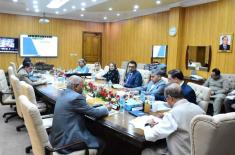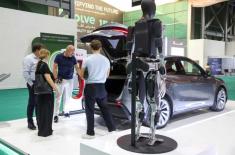
Chinese Team Designs Lead-free, Eco-friendly Solar Cells
Faizan Hashmi Published October 18, 2025 | 10:00 AM

SHANGHAI, (UrduPoint / Pakistan Point News / WAM - 18th Oct, 2025) Chinese scientists have created a tin-based solar cell that rivals the efficiency of conventional lead-based models while eliminating environmental and health risks, marking a significant advance for green energy.
The breakthrough, published in Nature, could accelerate the adoption of perovskite photovoltaics, a next-gen battery technology, in everyday applications.
Perovskite solar cells have been hailed as a potential game-changer for their high efficiency and low production costs, but their reliance on toxic lead has raised concerns about large-scale deployment.
Now, a team led by those from Fudan University has developed a lead-free alternative that achieves a record-breaking power conversion efficiency of 17.7 percent, the highest known level for such cells to date.
"Our goal was to create a solar cell that is truly green throughout its lifecycle," said Liang Jia, the study's co-corresponding author. Tin offers an ideal solution since it is "abundant, safe, highly compatible with solar energy conversion, and easy to manufacture at scale.
"
Since tin ions oxidise easily and the interface between layers tends to be unstable, early tin-based cells struggled to reach 10 percent efficiency.
Liang's team redesigned the buried interface by introducing a molecular film to form a homogeneous interfacial layer with well-matched energy level alignment.
This approach helps create a "superwetting" underlayer that guides the growth of uniform, high-quality tin-based perovskite films with reduced defect density, according to the study.
In terms of material cost, tin-based solar cells are theoretically much cheaper than their silicon counterparts, said Liang.
Looking ahead, this green photovoltaic technology is expected to be widely deployed in building-integrated photovoltaics, wearable energy devices, vehicle rooftops, and off-grid clean-power systems.
This technology is especially well-suited for energy applications that involve close human contact, explained Liang.
Related Topics
Recent Stories

UoG Syndicate okays key decisions at 52nd meeting

11th Pre-Owned Boat Show in Dubai to kick off with yachts, boats worth over AED2 ..

Giraffes return to Lahore Safari Park after eight years, bring joy to children, ..

ICC Women’s World Cup 2025: Rain interrupts match between Pakistan and New Zea ..

Punjab police launch crackdown on suspects Involved in cases of violent Protests ..

Trump-Putin meeting: White House’ press secretary faces backlash over inapprop ..

FAO marks 80th anniversary during participation in Abu Dhabi Global Food Week

PCB replaces Afghanistan with Zimbabwe for Tri-Nation Series in Pakistan

Gold price drops by Rs10, 600 per tola in Pakistan

ICC Women’s Cricket WC 2025: Pakistan women’s team set to Take on New Zealan ..

Pakistan’s delegation led by Defence Minister Khawaja Asif arrives in Doha for ..

Evolve Future Mobility Show in Sharjah highlights innovations shaping sustainabl ..
More Stories From Middle East
-
MBRHE reports steady progress on AED3.3 billion housing projects across four areas in Dubai
8 minutes ago -
Masfout’s recognition as ‘World’s Best Tourism Village’ highlights UAE’s global leadership ..
8 minutes ago -

11th Pre-Owned Boat Show in Dubai to kick off with yachts, boats worth over AED200 million on displa ..
38 minutes ago -
UAE concludes participation in Annual Meetings of World Bank Group, IMF in Washington
2 hours ago -

FAO marks 80th anniversary during participation in Abu Dhabi Global Food Week
2 hours ago -

Evolve Future Mobility Show in Sharjah highlights innovations shaping sustainable mobility
3 hours ago
-

'Ministry of Climate Change', IBM to develop AI solutions for enivornment
4 hours ago -

InfraX, Itron to accelerate smart utility, IoT solutions across UAE
5 hours ago -

NYU Abu Dhabi expands AI research, education initiatives
5 hours ago -

Pakistan estimates $2.9 billion in flood damages
8 hours ago -

Korea develops AI-powered warships
8 hours ago -

Chinese team designs lead-free, eco-friendly solar cells
9 hours ago








